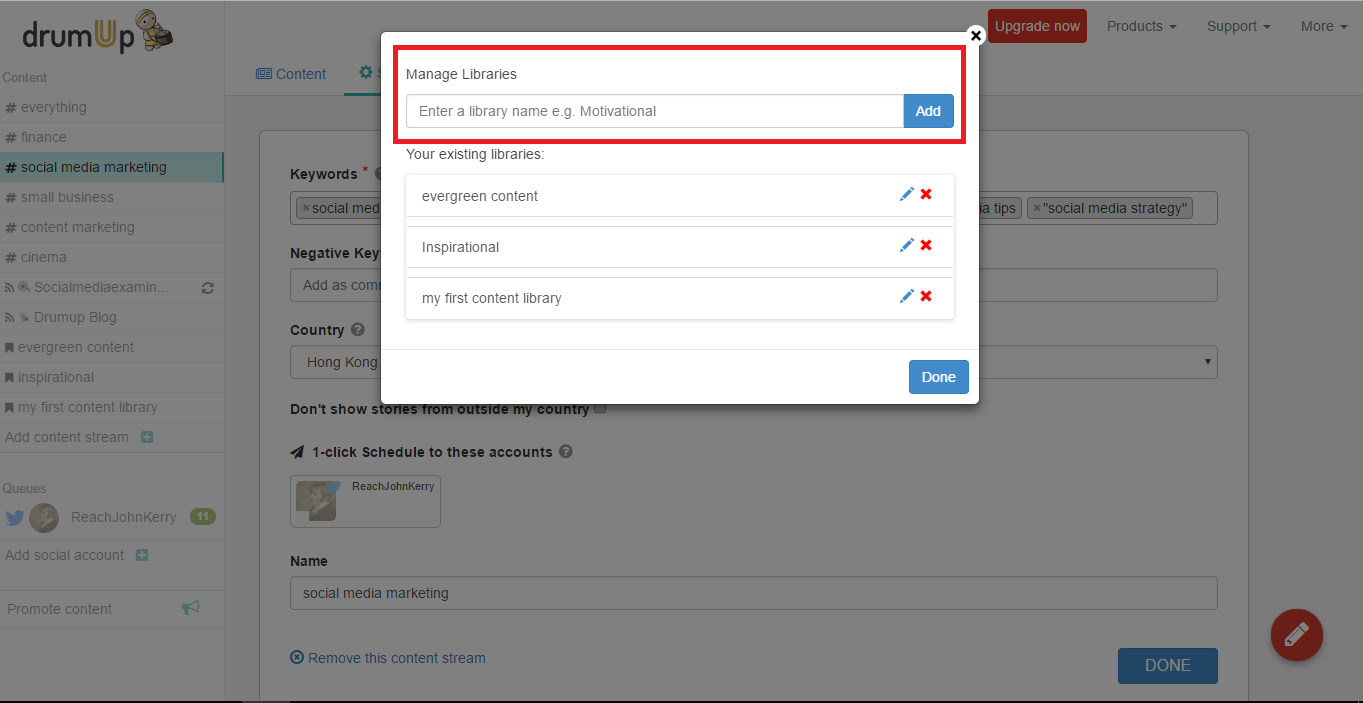We’ve come a long way in the last few years. Back in 2011, the biggest question that people were asking was if social was profitable. Since then, industry conversation has moved from ‘will I see an ROI’ to ‘how to measure social ROI’ and the tools that can help.
Yet, only 15% marketers have proven the impact of social media quantitatively. If you aren’t part of that 15% there could be two potential hitches – you aren’t working with a sound strategy, or you aren’t measuring the right metrics.
[ A sound strategy = targeted content + the right channels]
To eliminate the first possibility, let us study profitable social media content marketing strategies and compare them to our own.
1. ShipServ
Who’d have thought that a maritime e-commerce company would seize the social media opportunity and win at it? Shipping companies seem unlikely to be seeking information on social media, but ShipServ saw this differently. Since no one in their industry had conquered the social space, they moved in full force and established thought leadership in it.
ShipServ supplies software to support shipping companies and connects the industry’s vendors to buyers. In 2008, they were struggling with a host of marketing problems. They were selling technology to people who didn’t consider it necessary and on a limited budget. Creating that change in perception would be a huge task.
They began by studying their audience’s content consumption. They identified keyword themes to work with and planned a quarterly content and SEO strategy. A series of original content was promoted through a host of social media channels, driving traffic back to the main site. The channels they used included their blog, newsletters, Twitter, Facebook, LinkedIn and podcasts. They also ran a white-paper series and created a LinkedIn group.
The result?
400% more leads
150% more contact to lead conversions
3 month break even on the social media investment
(Source)
Takeaway tactics
1) Study your audience. One thing that people forget to do is to study how an audience consumes content, where exactly the look for it and what they look for.
2) Consider your content competition when building out a social strategy. One of the social media marketing mistakes that people make is blind-sighting content competition. ShipServ boomed on social because none of its competitors were on it yet. You need to identify a platform that has your audience and isn’t already monopolized by your competition. You need to share content with a unique value proposition.
2. Lyfe Kitchen
For a food industry product, social media marketing may seem like the clear-cut solution. But Lyfe Kitchen is B2B, a restaurant and grocery product line. A few years ago, this company wanted to increase word of mouth on social media and rapidly expand into new supermarkets. What should their approach have been?
The company ran influencer marketing programs, but with a slightly unconventional approach. They chose influencers who belonged to their high-potential target audience across industries – health and fitness, sports, the fashion world, and moms. In addition to this effort, the company also did tastings for a national sports company and magazine editors. The sports management company loved the product so much that they convinced their clients (sports celebs) to get on board. The editors wrote articles and talked about the product on social media.
The result?
Their product distribution grew from 400 to 1400 stores within a few months of the effort. The expansion was a result of direct requests to stock the product.
(Source)
Takeaway tactics
1) Tap into every vertical of your target audience. Don’t restrict yourself to one target demographic or group. Consider all possible consumers when creating your social media content or planning a marketing strategy.
This company considered influencers across so many verticals, from health and fitness to the fashion industry. They even included influential moms, who may have been instrumental in getting distribution to local supermarkets.
2) Look beyond the conventional. Don’t tunnel vision your marketing strategy. If you think laterally you may be able to accomplish more than just your major objective.
For instance, Lyfe Kitchen could have sent free samples to influencers or interacted with them separately. Turning the activity into an event provided a unique PR opportunity, and to make the Lyfe Kitchen experience more memorable and exciting for potential influencers.
3. Crate and Barrel
Crate and Barrel is a chain of American retail stores that sell home furnishings. Wait, so why did they create the ultimate wedding contest? Well, they did it to drive gift registry creation and engage new consumers in the process of it.
Participants were required to create a gift registry with Crate and Barrel to enter the contest (Note: A requirement like this one to enter a contest often introduces legal complexities). After verification of the registry, the participants could move on to the next stage – submission of a photograph and some answers to questions. The contest was then judged by public voting and a panel to pick the winner of a $100,000 fantasy wedding.
The contest was promoted on the company’s website, on-site in their stores and by advertisement.
The result?
Over 17,000 applicants, each with a minimum registry value of $2,000 (a net value of $34 million)
Direct access and engagement with the participants wedding guests, potential new customers
(Source)
Takeaway tactics
1) Craft marketing strategies that target both current customers, and new customers through them.
Crate and Barrel could have simply worked with the contest applicants, but the registry angle increased their reach exponentially (Please consider legal complexities before creating a campaign of this sort).
The simplest version of this tactic is to share the contest post to enter (which will give you access to your audience’s connections).
2) Make your unique value proposition exciting. A dream wedding of that value was certain to attract large application numbers. It was also compelling enough to make applicants want to get through stage one – the registry.
4. IBM
The popularity of ad blockers tells us this – people are growing immune to advertisement. In this market scenario, how do you reach your target audience? How do make someone willing to consume your content?
At IBM, it is all about people. The focus isn’t on the corporate blog or Twitter id, but the people who make the company. IBM has over 17,000 internal blogs, and a 100,000 active bloggers running that community. People are more likely to listen to other people than they are to a faceless brand.
IBM trains its social champions. They call themselves IBMers, and they are given the tools necessary to build a powerful social media presence. Thousands of people identify themselves as IBMers on Twitter and LinkedIn. I was surprised to see that the company culture remains with employees even when they leave IBM.
The result?
Over $100 million in crowdfunding
Over 40% in gross profit revenues
(Source)
Takeaway tactics
1) Invest in people. Employees, partners, well-wishers. There are over 40 studies to prove that they are more influential than official brand accounts on social media.
2) Use an employee advocacy platform to help your employees share your content on social. Build a powerful employee advocacy program that can achieve incredible reach and drive impact for your brand.
How to Be Profitable While Marketing on Social Media
So far, we have broken down profitable social media marketing strategies for insights. Now let us explore the basic framework that a social strategy requires to be profitable. Here five tips to help you implement a solid and returning social media marketing strategy.
1. Create awareness
2, Blog
3. Focus on the right platform
4. Collect and use audience data
5. Engage with your audience
1. Create awareness
Irrespective of your industry, brand awareness should be on your plan. Your target audience should be aware of the need for your product/service, what concerns of theirs it addresses and why they should choose your brand over others. Ensure that your business is known for something.
Begin by building a solid social media presence.
Organize your blog
Optimize your social media accounts
Participate in the relevant social media communities
Social media success depends on the value you create. You have to give away substantial value to succeed in a market where so much of it is already free. Do it HubSpot style, help potential clients achieve results by sharing free insights from your experience. Several companies see returns from their credibility and reputation on social media.
2. Blog
People seek help on the internet, and social media. It is no surprise that ‘How to’ is a heavily searched term. Your blog could be a powerful platform to field and answer queries that your target audience has. Like we discussed in the ShipServ case study, it is good to know exactly what they are asking first.
Share your expertise (make it unique)
Partner with bloggers and industry experts to create more value
Spend 20% of your time creating blog content, and 80% of it distributing it (on social, in email newsletters)
Your blog is an anchor to pull and hold your social media traffic. Ensure that the loop is complete though. Write blog posts that drive people to purchase your product/services. You don’t have to be promotional about it, you only have to show readers its use cases.
3. Focus on the right platform
Every platform you build a presence on is an investment of your time and money. Look at your budgeting as a mathematical equation. The variables (spends on each platform) on the left add up to the maximum budget that you have on the right.
Prioritize your platforms by their ROI
Accordingly allocate resources to your prioritized platforms
Track your progress and optimize your spends each month/quarter
Sometimes, the cost of work on a platform doesn’t justify what you earn out of it. In such a scenario, you could de-prioritize that platform and push something else up the priority list. Optimizing your effort and spends in this manner can help increase your overall social media ROI.
4. Collect and use audience data
Google Analytics has a module called ‘audience insights’. Based on visitor data, the module helps you understand more about who you are targeting and helps you identify the groups that you aren’t targeting yet. Social media platforms like Facebook and Twitter also give you demographics and user interests so you can build an informed content strategy.
Pull audience insights from Google and social media platforms
Keep the insights in mind when creating your content marketing strategy
Tailor content on each social media platform based on its audience demographics
Your audience will make a move only when encouraged by exactly the right content. The more you know about them and the more you consciously use that information, the better your conversions are likely to be.
5. Engage with your audience
There are many ways in which you can engage your social media audience. While you should engage them on your platforms, you should also go beyond them to target your potential audience. They don’t have to be consumers, they can be partners or simply enthusiasts.
Target communities, forums, websites and blogs that are popular in your industry
Don’t sell before your audience is ready. Begin by being useful to them regardless
Engage with your target market and people who have access to them
Consistency is key in a community. You have to establish yourself as an expert and really become part of your community. Becoming a thought-leader us even more effective, but that requires staying ahead of trends and covering the evolution of your niche.
It is possible to generate ample revenue from your social media pages alone, but you require clarity in terms of your goals and plan of implementation. With the right tactics, partners and tools, you can surprise yourself with your social media results.
Image credit: Pixabay.com


















